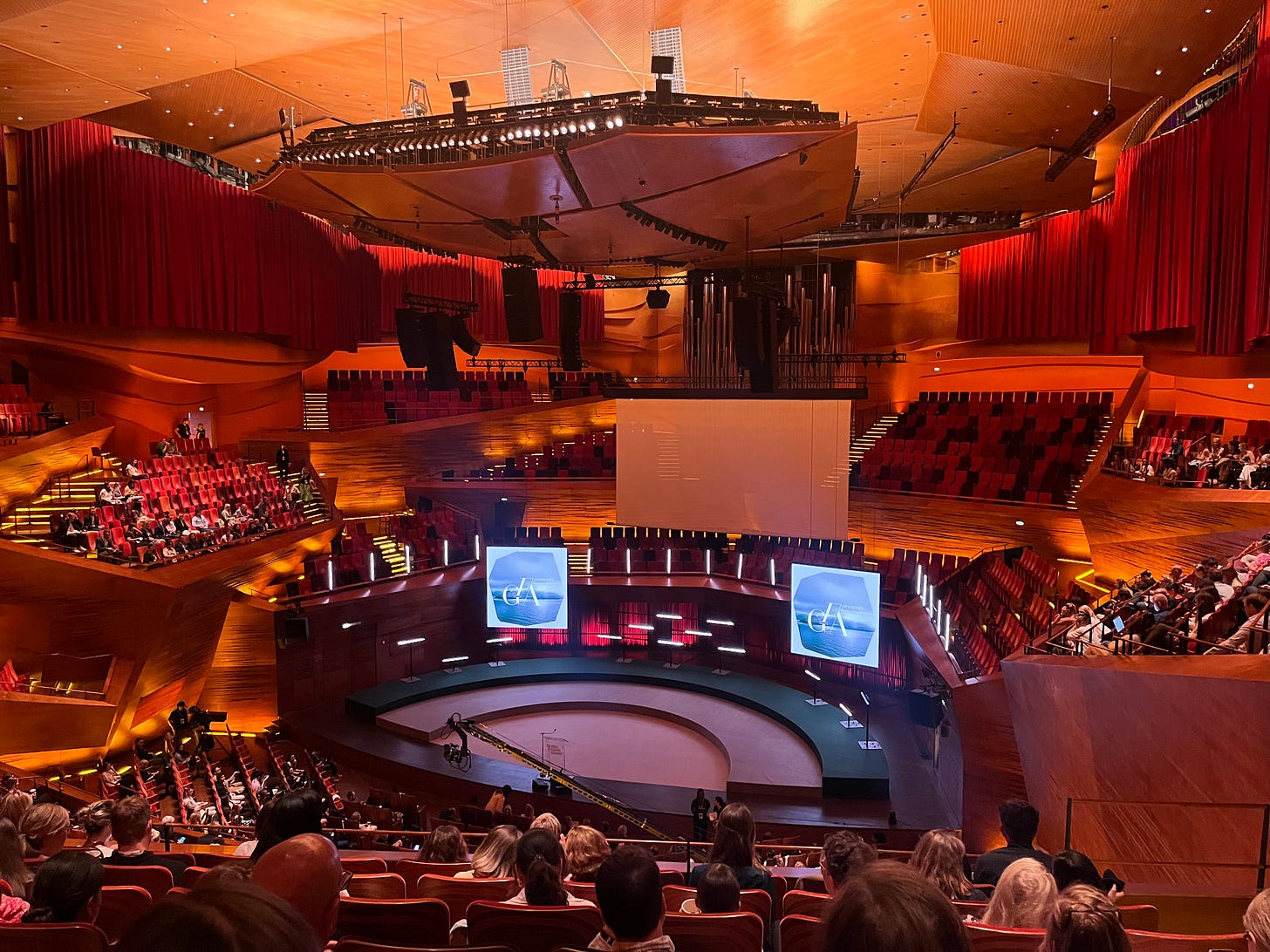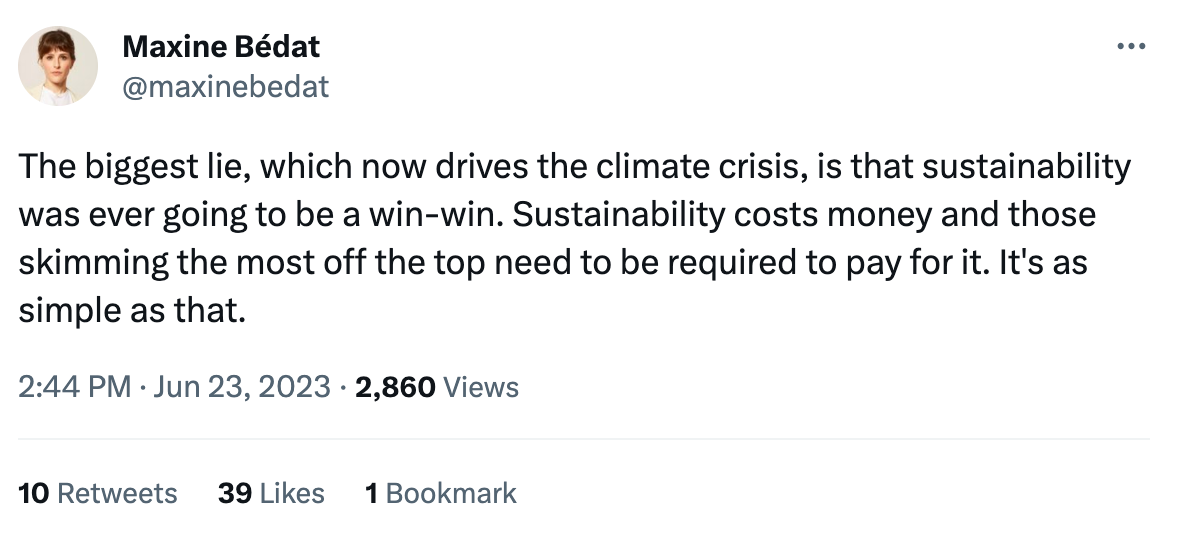Interpolations
What was unsaid at the Global Fashion Summit?
Last month I attended GFA’s Global Fashion Summit in Copenhagen, a 2-day conference gathering fashion and sustainability professionals in Copenhagen for a series of panels and presentations that aimed to move beyond ‘talk’ and towards ‘action’ on fashion’s negative social and environmental impacts.
Amongst the packed agenda, Dr. Hakan Karaosman’s inspiring talk on the limits to growth offered an important reminder that a just transition means co-creating climate targets and strategies with, not for, suppliers, and refusing to jump ship when things get challenging. I also got a dose of hope from Dr. Anna R. Kelles’ speech about the New York Fashion Act - a supply chain due diligence law that if passed, would fine companies up to 2% of annual revenues for non-compliance. I also cheered at Dr. Katia Vladimirova’s invitation to build a sufficiency wardrobe of just 5 new items per year, and Seema Joshi’s call for brands producing in Vietnam to advocate for the release of Vietnamese climate activists being sent to prison.
Overall, there wasn’t any tangible action talked about by the most influential speakers, beyond re-stating the urgent need for collaboration. One of the best reviews of the summit I’ve seen is from BoF’s Sarah Kent:
“On the sidelines, many conversations focused on what was left unsaid on the main stage, where large brands were often allowed to put an optimistic sheen on slow progress without challenge. What wasn’t much discussed was the question of money — a critical and divisive issue. Meeting fashion’s sustainability goal is going to cost billions of dollars and most of that is going to need to be spent in the supply chain. Who should pay and how is a live issue made particularly delicate by the broader gloomy economic climate. Manufacturers say they are facing an impossible squeeze from brands who are demanding lower prices, while also pressing for major eco-investments. But the subject got little air time at the summit. Until that question of climate funding is really addressed, it’s hard to see action taking place at scale.”
Interestingly, this paragraph is followed by a disclosure that LVMH holds a minority interest in The Business of Fashion. This uncomfortable conflict of interest reminded me of the recent news that LVMH has attracted 1,200 ESG funds that have amassed a combined stake worth more than US$17 billion. As Ken Pucker commented on Linkedin, with 5.7million metric tonnes of CO2e (equivalent to 1,268,423 petrol-powered cars driven for one year) from scope 3 produced by LVMH in 2022, ‘what is the connection between an ESG fund and planetary welfare?’
LVMH also sponsored the Global Fashion Summit’s celebration dinner, and its billionaire nepo-baby Head of Image and Environment (what?) Antoine Arnault led the first conference session on ‘luxury’s sustainable development’, where cutting remarks were made about luxury fashion being ‘inherently sustainable’ unlike fast fashion (lol), and #humblebrags were offered about Louis Vuitton’s traffic-stopping Paris Fashion Week show, which rumours suggest cost over $350million to produce - but wait! The set designs are sometimes recycled or reused in stores!
All this is to say, there is an increasing threat that mega-brands like LVMH have been allowed to define the problems, propose the solutions, and control the narrative, not just about their own business, but about sustainability and circularity in the entire fashion industry. What can we read between the lines?
The conversations at this conference, and every conference, have become so complicated that they require endless sustainability executives and experts detailing their unique and well-branded approaches to the problem of climate catastrophe. But too often this clouds the simple, inconvenient truth that science sets the limits for us. Science tells us what we need to do, and when we need to do it. Anything that’s not drastically cutting greenhouse gas emissions, eliminating fossil fuels, reducing resource consumption, and restoring biodiversity is a misguided distraction at best, and a deliberate misdirection at worst.
Maxine Bédat summed up this issue perfectly here, which was echoed by Ken Pucker in this brilliant podcast:
Will we continue accepting the crumbs that Sustainability Inc., feeds us?
Thank you for reading this email and apologies for the delay this month, I’m blaming the stress/chaos of moving house/city 🥱 Until next time, I’ll leave you with three reading recommendations:
Sophie Benson’s brand new book Sustainable Wardrobe comes out 7th September, and the hardback is available to pre-order now. I can’t wait to read Sophie’s undoubtedly fresh take on taking a more responsible approach to our individual fashion habits. Huge congratulations to Sophie for this important debut!
The UNEP has released its new Sustainable Fashion Communications Playbook which covers in detail how fashion communicators from all corners of the industry can transform traditional narratives that promote overconsumption and enable greenwashing, and promote a more regenerative and inclusive fashion future through storytelling.
I met the wonderful Tanita Hecking in Copenhagen, who together with Lavinia Muth writes The Crisps newsletter - aptly named for providing ‘snacks’ of sustainable fashion analysis and crisp (see what I did there) critiques of myths and misinformation in the sector.



